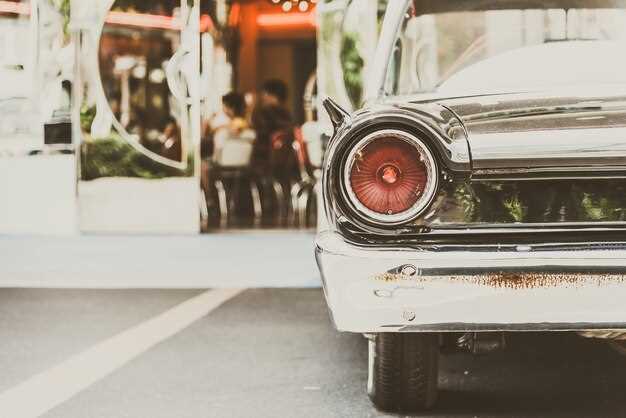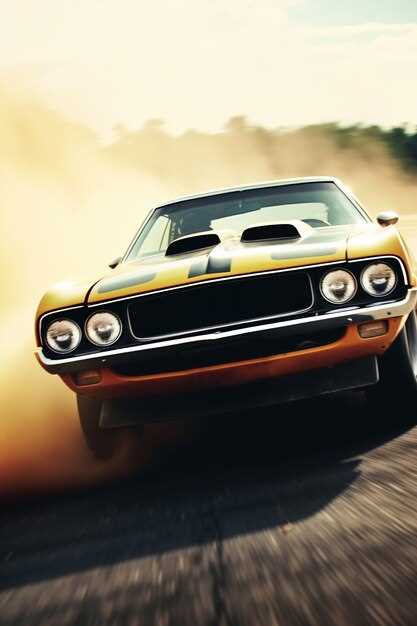Prioritize originality when restoring a muscle car. Authentic parts not only enhance the vehicle’s value but also maintain its historical significance. Seek out original factory components or high-quality reproductions to ensure an accurate restoration. Joining muscle car forums or clubs can connect you with enthusiasts who share valuable resources and leads on hard-to-find parts.
Assess the condition of the body before anything else. Rust and structural damage can greatly affect the restoration costs and timeline. Use a careful inspection process to determine if metal repairs or replacements are necessary. Investing in good bodywork is paramount, as it serves as the foundation for the entire restoration project.
Don’t overlook the importance of the engine and drivetrain. Depending on your goals–whether for cruising or competitive racing–select the right performance upgrades. Research engine specifications and compatibility to choose parts that truly enhance performance without compromising reliability.
Stay organized throughout the process. Documenting every step, from disassembly to reassembly, can prevent confusion and save time. Create a detailed project plan that includes a timeline, budget, and specific tasks. This approach helps you track progress and make adjustments as needed, ultimately leading to a successful restoration outcome.
Identifying Authenticity: How to Verify Original Parts
Check the part numbers. Genuine muscle car parts usually have specific numbers stamped or printed on them. These numbers can often be cross-referenced with manufacturer databases or parts catalogs to confirm authenticity.
Inspect the material and finish. Original parts often reflect the manufacturing techniques and materials of their time. Look for signs of age, such as patina or unique finishes that modern reproductions may lack.
Examine the overall physical characteristics. Pay attention to aspects like the weight, shape, and fit of the part. Original components frequently have subtle variations that reproductions do not replicate.
Consult with experts. Connect with vintage car clubs, restoration shops, and online forums dedicated to muscle cars. Enthusiasts with hands-on experience can provide valuable insights and help verify the originality of parts.
Request documentation. Original parts might come with service records, build sheets, or authenticity certificates. While not all originals will have this documentation, having it can significantly bolster claims of authenticity.
Look for trusted vendors. Reputable sellers who specialize in classic car parts often provide guarantees of authenticity. Be wary of deals that seem too good to be true, as they frequently involve counterfeit items.
Join restoration workshops or attend car shows. Engaging with the community allows for an exchange of knowledge about specific parts and their characteristics, enhancing your understanding of what makes an original part truly original.
Understanding the Cost: Budgeting for a Restoration Project
Establish a clear budget before diving into any muscle car restoration. Outline major expense categories like parts, labor, and materials. Allocate 40-60% of your budget for parts like engines, interiors, and body panels. Research these costs online to create a realistic estimate.
Factor in labor if you’re not doing the work yourself. Hiring a professional can significantly increase costs, often ranging from $50 to $150 per hour. Assess your own skills and decide what tasks you can handle, saving money in the process.
Don’t overlook the cost of tools and equipment. Investing in quality tools can prevent future expenses related to repairs or rental. Having essentials like wrenches, hoists, and paint sprayers will be beneficial long-term.
Include costs for unexpected repairs. Restoration projects often reveal additional issues, so set aside 10-15% of your total budget as a contingency fund to address surprises that arise.
Consider customizing features or upgrades carefully. While they can enhance your muscle car, they often come with high price tags. Prioritize which customizations truly matter to you and calculate their costs accordingly.
Finally, track expenses meticulously throughout the project. Use spreadsheets or apps to monitor spending and ensure you stay within your budget. Regular evaluations can help prevent overspending and keep your project on track.
Choosing the Right Tools: Essential Equipment for Restoration
Select quality hand tools for muscle car restoration. Invest in wrenches, ratchets, and socket sets to tackle engine and chassis work. A good set of screwdrivers with various tips prevents stripping screws and allows for more straightforward repairs.
Power tools can boost efficiency. Use an angle grinder for metal work and a drill for various tasks. A high-quality impact wrench speeds up disassembly without compromising bolt integrity. A plasma cutter is handy for more intricate cuts.
Safety equipment is non-negotiable. Keep safety glasses, gloves, and a durable respirator nearby. These protect against debris, harmful fumes, and dust during restoration tasks.
Invest in a reliable jack and jack stands for safe vehicle support. This setup allows you to work under the car comfortably. A creeper can enhance movement while underneath, so consider adding one to your toolkit.
Organizational tools improve efficiency. Storage bins and magnetic trays help keep small parts in order and reduce the likelihood of losing components. Label your storage for easy identification when reassembling.
Lastly, consider purchasing a comprehensive repair manual for your specific muscle car model. It provides valuable diagrams and specifications, ensuring adherence to manufacturer guidelines during restoration.
Finding Reliable Suppliers: Sourcing Quality Replacement Parts
Begin your search for reliable suppliers by joining online forums or communities dedicated to muscle car restorations. Engage with experienced enthusiasts who can recommend businesses with a solid reputation for quality parts.
Check for suppliers that specialize in muscle cars. Focus on those offering original equipment manufacturer (OEM) parts or high-quality aftermarket alternatives. Research their websites for detailed product descriptions and customer reviews to gauge quality standards.
Attend local car shows and swap meets to network directly with vendors and other car enthusiasts. Personal interactions often reveal more about a supplier’s reliability and the quality of their offerings.
Verify the supplier’s return policy, warranty on parts, and customer service responsiveness. A trustworthy supplier stands by their products and supports their customers.
Utilize social media platforms and groups. Look for recommendations and feedback from fellow restorers. Social proof can significantly aid in selecting dependable suppliers.
Cross-reference multiple suppliers for price comparisons and availability. A wide range of options helps you avoid overpaying while ensuring you don’t compromise on quality.
Lastly, inquire about sourcing processes and how suppliers maintain quality control. Understanding their operations will give you confidence in their products.
Restoration Techniques: Strategies for Paint and Bodywork
Begin with a thorough inspection of the vehicle’s body. Look for rust spots, dents, and damaged areas. Treat rust immediately to prevent further damage; use a wire brush and rust-inhibiting primer. For small dents, consider using a paintless dent repair method that keeps the original paint intact.
When it comes to paint, choose high-quality polyurethane or acrylic enamel for durability and longevity. Prepare the surface meticulously; sand the existing paint to create a smooth base. Utilize a primer that matches your chosen paint type, ensuring proper adhesion.
For the painting process, employ a spray gun rather than aerosol cans. This method allows for better control and a more even application. Keep the gun at a consistent distance from the surface to avoid runs or overspray.
Allow each coat to dry completely before applying the next. Generally, two to three coats of paint provide optimal coverage. Follow up with wet sanding between coats for a flawless finish, using 2000-grit sandpaper.
Once the final coat dries, apply a clear coat for added protection and sheen. Choose a clear coat that complements your paint. After the clear coat cures, use a polishing compound for a glossy finish. This enhances the depth of color and protects against UV damage.
Here’s a quick reference table summarizing the steps:
| Step | Description |
|---|---|
| Inspection | Examine for rust, dents, and damage. |
| Rust Treatment | Remove rust with wire brush and apply primer. |
| Surface Preparation | Sand the original paint for better adhesion. |
| Painting Method | Use spray gun for even application. |
| Coat Application | Apply two to three coats with drying time in between. |
| Clear Coat | Apply for added protection and shine. |
| Final Polishing | Use polishing compound for a glossy finish. |
By following these strategies, you enhance not only the aesthetics but also the value of your muscle car restoration project. Attention to detail in paint and bodywork ensures lasting results and an impressive final appearance.
Performance Upgrades: Enhancing Power While Maintaining Classic Appeal
Upgrade your muscle car’s performance with targeted enhancements that respect its classic roots. Here are key upgrades to consider:
- Cold Air Intake System: This modification increases airflow to the engine, promoting better combustion. Select an intake that complements the car’s existing aesthetics.
- Performance Exhaust System: An aftermarket exhaust can provide a deeper sound while improving the engine’s efficiency. Look for systems that enhance both flow and appearance without overwhelming the classic style.
- ECU Tuning: Adjusting the engine control unit to optimize performance parameters can yield significant power boosts. Choose a tuning option that maintains compatibility with your car’s vintage specifications.
- Upgraded Carburetor or Fuel Injection: Depending on your engine type, either upgrading the carburetor or switching to fuel injection can result in improved fuel delivery and performance. Ensure compatibility with the original engine setup.
- High-Performance Tires: Investing in modern tires can improve grip and handling without altering the classic look. Opt for performance tires that fit your existing wheels while enhancing traction.
- Suspension Upgrades: Consider installing performance shocks and springs. This enhances handling without compromising the driving experience. Maintain the vehicle’s original ride height for that classic stance.
- Brake System Optimization: Upgrading to disc brakes can significantly improve stopping power. Choose options that blend in with the car’s classic profile.
Conduct thorough research before making modifications. Prioritize components that enhance reliability and drivability while keeping the classic character of your muscle car intact.







